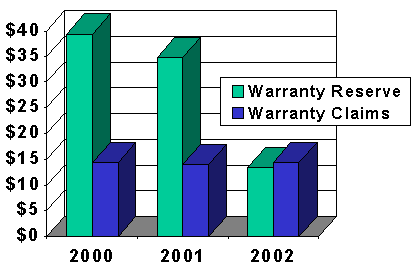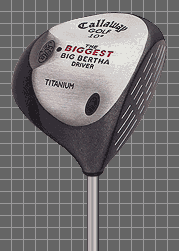Clash of the Titaniums
How a golf club maker turned a shiny metal into a reason to dump its auditors.
by Eric Arnum, Editor
On this particular Monday morning, perhaps the last thing one might expect to read is an article about a golf club maker's warranty accounting practices. However, last week the Callaway Golf Company of Carlsbad, California quietly made financial news by explaining in detail how they sacked their auditors over a dispute about funds set aside to pay warranty claims.
This is not a story about another Enron-style accounting collapse, nor is there any sort of juicy scandal inherent in its telling. It's merely an actuarial story with a warranty twist that we dare say is somewhat interesting. So next time there's a lull in your golf game banter, point to someone's titanium driver or their Odyssey putter and tell them the following tale:
 Once upon a time in 1982, the Callaway Golf Company was founded by Ely Reeves Callaway Jr. (1919 - 2001), a retired textile executive and a California vintner who came across a new idea for a stainless steel golf club. That club was dubbed the Big Bertha Driver, taking its name from a World War I German cannon famous for its long-distance capabilities.
Once upon a time in 1982, the Callaway Golf Company was founded by Ely Reeves Callaway Jr. (1919 - 2001), a retired textile executive and a California vintner who came across a new idea for a stainless steel golf club. That club was dubbed the Big Bertha Driver, taking its name from a World War I German cannon famous for its long-distance capabilities.
Rocket Science
Stainless steel had already replaced the hickory stick golf clubs Mr. Callaway and others used in their younger years (in the 1930s he won four consecutive local championships while still in his teens). But his company used an innovative mix of steel, wood and graphite to redistribute the weight of the club in a manner that allegedly helped "straighten out" bad shots.
By 1990, the Callaway Short, Straight, Hollow Hosel (also known as the S2H2) was number one on the Senior PGA Tour. Meanwhile, Callaway's Odyssey putter took over that segment of the club market.
In 1997, Callaway introduced the Biggest Big Bertha Driver, which used titanium as well as steel in its construction. At the time, titanium was the new "in" material, having come in from the Cold War and the Space Race, where its relative strength and lightness made it a favorite material for everything from airplane wings to ship propellers.
Titanium had a few more interesting properties. Because it didn't rust or corrode, it didn't need painting. Instead, it remained eternally shiny, like gold or platinum. And it retained its shape, resisting bending and denting even better than steel. It also retained its size through much greater temperature extremes. These properties opened up titanium to new civilian and commercial uses from jewelry to artificial hips.
Back in 1997, titanium watches were all the rage. The metal had a high-tech look and feel that attracted artists, designers, and architects. The newly-opened Guggenheim Museum in Bilbao, Spain, was wrapped in the shiny stuff, seemingly defying gravity with computer-designed curves that could not have been built with steel. Even credit card companies used a titanium ranking to convey a cachet upon its holders that mere platinum could not.
But titanium for golf clubs? Almost immediately, Callaway ran into objections from those who thought the use of space-age metals could give some players an unfair advantage. Without mixing too much science into this accounting tale (click here for Physics World), the powers that be in the golf world created a standard for the maximum allowable "spring-like effect" of a golf club that excluded titanium clubs.
They even invented a machine that could test the effect, which involved the use of a pendulum that swings a metal mass into the driver, and measures the amount of time they remain in contact. It seems the bounce is bigger off titanium, and thus the ball travels faster and further.
Budgeting for Warranty Claims
As if those physics experiments weren't enough of a problem, Callaway also discovered problems with the manufacture of the titanium driver's shafts that it believed could someday elevate the rate of product returns. So the company began budgeting for larger-than-typical warranty claims, raising the size of its warranty reserve fund as high as $39.4 million (4.7% of sales) by the end of 2000. However, the expected surge in warranty claims never materialized. So it turned out that the warranty reserve was a lot larger than was necessary.
The company's business, meanwhile, came under increased attack from golf's governing body. The executive committee of the U.S. Golf Association actually tried to ban the sale of Callaway's Big Bertha ERC II Forged Titanium Driver, because the clubs allegedly allowed players to hit the ball much further than was typical. When an outright ban failed, the USGA said scores shot with the help of the ERC II shouldn't be counted for handicapping purposes. In the North American market, Callaway was reduced to selling the titanium driver for use only in recreational or social rounds of golf.
Business slowed, but not terribly so. Callaway was aiming at the average amateur player anyhow. So while the rules against the use of the titanium clubs among professional tournament players hurt, the publicity about this magical driver that could turn bad shots into good shots actually helped sales among amateurs.
It also helped that half the company's sales were made outside the U.S., where USGA rules didn't apply. However, last year the USGA and the Royal & Ancient Golf Club of St. Andrews, Scotland (which sets rules for the rest of the world) announced a deal that sets a five-year transition period during which the drivers used in international competitions can optionally be required to meet USGA standards. After Jan. 1, 2008, the USGA's so-called 0.830 coefficient of restitution becomes the mandatory worldwide standard.
Steady Warranty Costs
Callaway's warranty costs, meanwhile, remained amazingly stable. In 2000, 2001, and 2002, warranty claims stayed within a very tight range of $14 to $14.4 million per year. Sales, meanwhile, slowly declined from $837.6 million in 2000 to $816.2 million in 2001 and $792.1 million in 2002. This means that warranty claims accounted for 1.7% of total sales in 2000; 1.7% of sales in 2001; and 1.8% of sales in 2002.
Callaway Golf Company
Warranty Reserve & Claims
2000 to 2002

Source: Callaway Golf
In 2000, Callaway added $17.6 million to its warranty reserve fund, which turned out to be $3.26 million more than was needed. So in 2001, Callaway added only $9.5 million to the fund, thereby allowing it to shrink by $8.1 million in size by year's end. Then in 2002, Callaway let the balance drop further to only $13.5 million, and made a decision to permanently change the "methodology of estimating warranty accruals."
Callaway's own accounting efforts determined that the fund could be dramatically reduced in size without impacting the company's ability to fund future warranty claims. The company announced that it had determined through "better record-keeping" that its warranty reserve was exactly $17 million too large for the amount of claims it was then experiencing.
Overestimated Reserves
In its earnings statement for the third quarter of 2002, Callaway said it "has observed a downward trend in actual costs over the past two years associated with warranty claims due to improved product engineering and manufacturing processes combined with a reduction of costs associated with resolving claims."
As the company further explained in its annual report:
- "Beginning in the second quarter of 2001, the company began to compile data that illustrated the timing of warranty claims in relation to product life cycles. In the third quarter of 2002, the company determined it had gathered sufficient data and concluded it should enhance its warranty accrual estimation methodology to utilize the additional data. The analysis of the data, in management�s judgment, provided management with more insight into timing of claims and demonstrated that some product failures are more likely to occur early in a product�s life cycle while other product failures occur in a more linear fashion over the product�s life cycle. As a result of its analysis of the recently collected additional information, the company believes it has gained better insight and improved judgment to more accurately project the ultimate failure rates of its products. As a result of this refinement in its methodology, the company concluded that it should change its methodology of estimating warranty accruals and reduce its warranty reserve by approximately $17,000,000." (Click here for more excerpts.)
 The company then told its auditors at KPMG LLP that the entry was to appear as a reduction in the cost of goods sold, accounted for in its entirety during the quarter in which the estimate was corrected. After taxes, that meant a $10.5 million increase in gross profits for the third quarter -- a 15% boost.
The company then told its auditors at KPMG LLP that the entry was to appear as a reduction in the cost of goods sold, accounted for in its entirety during the quarter in which the estimate was corrected. After taxes, that meant a $10.5 million increase in gross profits for the third quarter -- a 15% boost.
This accounting method would not change the amount of reported revenue, but it would radically alter the company's profitability. In fact, the 11 cents earnings per share the company eventually reported for the third quarter of 2002 would have been a 5 cents per share net loss had it not been for the change in the warranty reserves. It's also worth noting that the one-time earnings boost helped obscure the effects of a 21% year-over-year decline in sales of drivers from 2001 to 2002.
For the entire year, the company's reported 26% increase in earnings per share would instead have been a 15% decline, were it not for the one-time boost from the warranty fund. Gross profit margins, rather than remaining steady at 50%, would have fallen to 48% in 2002 had it not been for the warranty adjustment.
Before and After
What follows is an accounting of how the books would look both with and without the warranty reserve fund adjustment:
| Net income: | |
| As Reported | $69.4m |
| Adjustment (after tax) | - 10.5m |
| Without the $17m | $58.9m |
| Basic earnings per share: | |
| As Reported | $1.04 |
| Adjustment | - 0.16 |
| Without the $17m | $0.88 |
| Diluted earnings per share: | |
| As Reported | $1.03 |
| Adjustment | - 0.16 |
| Without the $17m | $0.87 |
KPMG agreed that the warranty reserve should be reduced by $17 million. However, the auditors wanted to treat the excess amount as a cumulative error -- a series of past overestimates that would be corrected retroactively. Rather than a big one-time boost to profitability in a single quarter, this approach would add a few percentage points to each of several past quarterly reports.
Callaway faced a tough choice between restating years of earnings or firing their auditors. They chose to do the latter.
In Dec. 2002, only eight months after hiring them, Callaway Golf dismissed the KPMG audit team, and replaced them with Deloitte & Touche LLP. It was the culmination of a long-simmering disagreement between the golfers and their auditors, which Callaway has said wasn't so much about the warranty reserve as it was more about the delays in resolving the matter (the third quarter report was filed at least two months late).
Said the company:
- "Management believed that the reduction was the result of a current change in the estimation process, and that therefore the entire reduction should be reflected in the third quarter. KPMG ultimately advised the company that a substantial portion of the reduction related to periods prior to 2002, and the company�s financial statements for prior periods should be restated for a correction of an error to reflect the warranty reserve based upon the best information available to the company at the time those prior period financial statements were prepared. Despite lengthy discussions between management and KPMG, including consultation with the staff of the Securities and Exchange Commission, management and KPMG could not reach agreement on a proper accounting treatment.
"The Audit Committee and the Audit Committee Chairman reviewed the matter with management and KPMG on several occasions, both informally and at formal meetings of the Audit Committee. Meanwhile, the company�s filing of its Form 10-Q for the quarter ended September 30, 2002 was delayed. Ultimately, the Audit Committee recommended to the Board of Directors that a new auditor be engaged to assist in bringing the matter to a conclusion. The Board agreed that, without regard to the ultimate resolution of the warranty issue, it would be in the company�s best interests to change auditors at that time. The company authorized KPMG to respond fully to the inquiries of the successor accountant concerning the disagreement." (Click here for more excerpts.)
Surprisingly, investors took the news rather well, judging by the company's stock price (NYSE: ELY). While shares dipped below $12 around the time the news of the firing broke in mid-December, they remained significantly above the 52-week low of $9.42 that was set a few months before, during the market downturn of Oct. 2002.
Stock Price Recovers
Also, while so far in 2003 the stock has spent much of the time below $12, it recently has climbed its way back. On Friday, March 21, a few days after the company's detailed explanation of the accounting disagreement was released within its annual report, Callaway closed at a price of $12.15, once again above $12 per share.
Callaway Golf (NYSE: ELY)
One-Year Stock Chart
Source: NYSE
The end result for Callaway is that it got its way. The earnings boost helped to shore up an otherwise weak third quarter, evening out the company's net income and preventing Callaway from having to report back-to-back net losses (the fourth quarter of 2002 was unprofitable). The controversy over the company's use of titanium brought it untold amounts of free publicity. And it turned out that the titanium wasn't as much of a quality problem as was initially feared, or at least it wasn't as costly as was once projected.
The bottom line is that Callaway discovered that its warranty reserve fund could be cut by more than half with no effect on the company's ability to pay claims. And it convinced two accounting companies that its new estimates were correct. Unfortunately, it couldn't convince one set of auditors that since the estimate was changed all at once, that the gains should be realized all at once.
Another Warranty Matter
KPMG has remained silent about the whole dispute. However, Callaway isn't the only company to ever disagree with its auditors about warranty reserves. Another company called Inamed Corp. also is entangled with KPMG over the proper accounting procedures to use for its warranty reserves.
The medical device company said last summer, after delaying the release of its second quarter earnings report, that it might need to increase its warranty reserve by some $1.5 million to fund future breast implant warranty claims. According to an Aug. 12 press release, "The company forecasts the amount of potential future claims from this warranty based on actuarial analyses. These forecasts have then been discounted and booked as liabilities. The company is currently reviewing whether discounting is appropriate and, if so what the proper discount rate should be. The company may need to increase its warranty reserve by as much as $1.5 million after taxes."
The review is ongoing. KPMG remains the company's auditors. After the closing of Inamed's calendar year 2002 books and up through the Feb. 25 release of its annual report, the company has not announced any changes to its potentially under-accrued warranty reserve. Revenue for 2002 was reported as $275.7 million, up 15.5% from 2001. The cost of goods sold rose by a proportional amount, and gross profit remained steady at 71.8%. Operating income was up 19.5% to $46.5 million. Net income was up 57% to $32.9 million.






